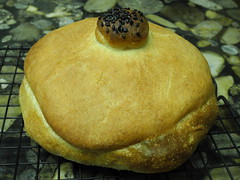 Catch-up time again--I'm now on schedule for the BBA Challenge baking, and if I get three blog posts done I'll be completely caught up. On the Challenge, that is...let's not discuss other aspects of my world that are behind schedule or just out of control.
Catch-up time again--I'm now on schedule for the BBA Challenge baking, and if I get three blog posts done I'll be completely caught up. On the Challenge, that is...let's not discuss other aspects of my world that are behind schedule or just out of control.Next up after the pain à l’ancienne was pain de campagne, "country bread". It is made with a light sourdough starter (pâte fermentée), and has a little whole-wheat flour in addition to the unbleached bread flour. I did a half recipe of the pain de campagne, but looking ahead I made a full recipe of pâte fermentée and froze half for the pane siciliano coming up. Thanks to a weekend out of town, the pâte fermentée for the country bread spent a couple of extra days in the fridge and acquired a little extra sourdough character before I made the bread.



No issues with making the dough or kneading it (by machine, as always). The dough rose very quickly, and I just shaped the dough when it had doubled. Short on time, I didn't follow the instructions to degas it and let it rise again if it doubled in under two hours, I moved on to the shaping. This dough is supposed to lend itself to a variety of shapes. I divided my dough in half and started with one auvergnat (a cap) and a fendu (split bread), then converted the fendu to a couronne (crown) on second thought. My cap manage to remain rather cap-like after rising with it's sesame-seeded topknot, but my crown ended up as a rather featureless oversized doughnut shape.
The recipe calls for hearth baking with the bread directly on the baking stone. However, I grabbed polenta instead of cornmeal or semolina to dust my parchment paper, which was too gritty and I then couldn't get loaves off the paper they proofed on. Oh, well, so the bread baked on paper. I did manage a good blast of steam, and the resulting loaf was nicely crusty.
 Tasting results: Lovely browned crackly crust and a very chewy texture like the pain à l’ancienne. Without side-by-side comparison the only distinct difference I get is the flavor from the small amount of whole-wheat flour, and perhaps a little from the long pre-ferment. Not really strong, though. Still and all, a very nice bread.
Tasting results: Lovely browned crackly crust and a very chewy texture like the pain à l’ancienne. Without side-by-side comparison the only distinct difference I get is the flavor from the small amount of whole-wheat flour, and perhaps a little from the long pre-ferment. Not really strong, though. Still and all, a very nice bread.
I liked the taste of this one, and yes my crown shaping sealed up during the baking too? The cap was better at holding the shape, my fendue became a baguette ,no split at all? It's dissapointing,as there are no further reasons given for misshapes.
ReplyDelete